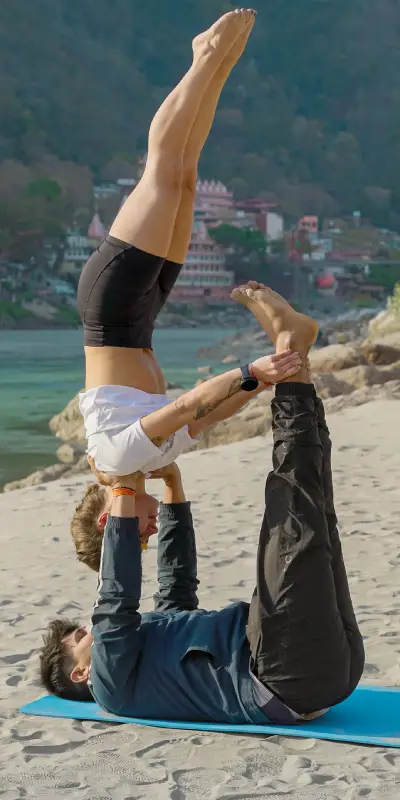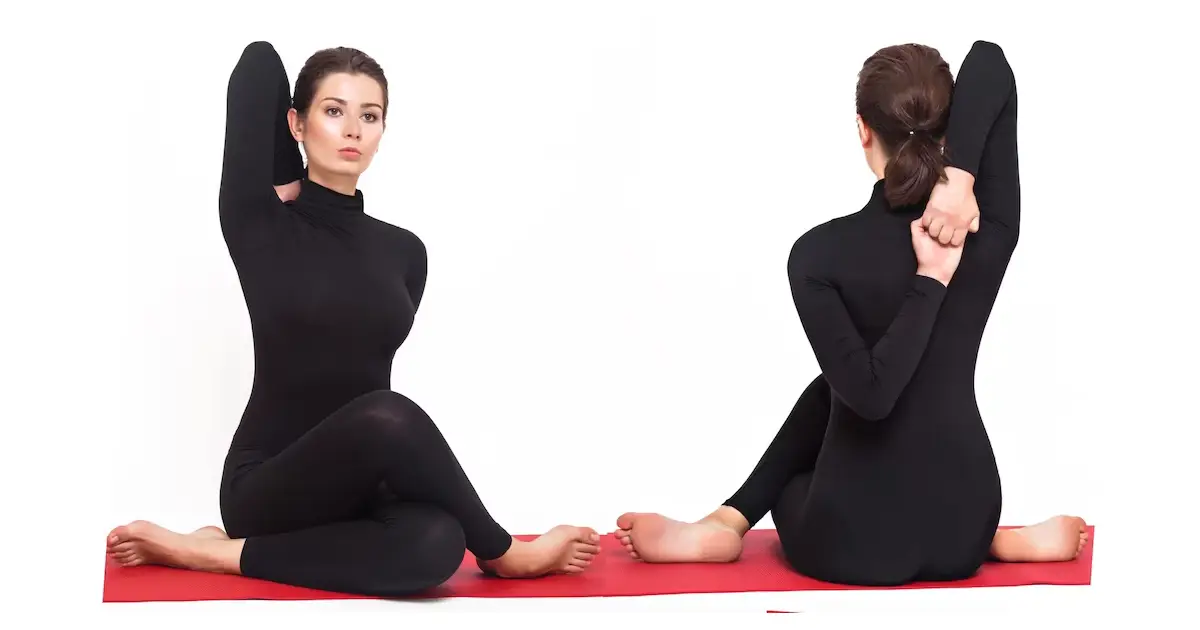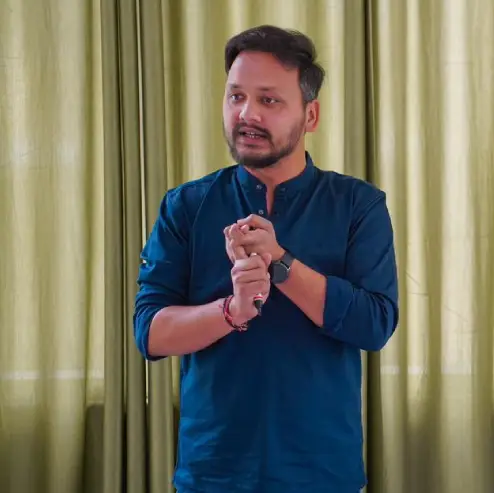
Get A Free Quote


Welcome to the enchanting world of Gomukhasana, the Cow Face Pose, a yoga asana that beautifully blends balance and flexibility. This intriguing pose offers a unique combination of stretching and strengthening, perfect for yoga enthusiasts at any level.
At a glance, Gomukhasana may seem like a straightforward seated pose. However, it's much more than that. This asana is a journey into discovering symmetry in your body and exploring its potential. Derived from Sanskrit, 'Go' means cow, 'Mukha' means face, and 'Asana' means pose, the Cow Face Pose mimics the appearance of a cow's face with the unique arrangement of your legs and arms.
Gomukhasana is notable in yoga for its comprehensive impact on various body parts. This asana is not just a pose; it's a complete experience that nurtures both the body and mind. It effectively targets your ankles, hips, thighs, shoulders, and arms, making it an allencompassing practice.
Particularly relevant in today's sedentary lifestyle, Gomukhasana serves as an antidote to the downsides of prolonged sitting. It opens up oftenneglected areas like the hips and shoulders, while also working on the triceps and the rotator cuff, offering a rewarding stretch for the upper body.
The real charm of Gomukhasana lies in its accessibility. Whether you're just starting in yoga or have been practicing for years, this pose can be tailored to your level. For beginners, it's an excellent introduction to the principles of balance and body awareness, prompting a focus on posture and breathing. More seasoned yogis will find this pose a challenge to their flexibility and endurance, often uncovering subtle imbalances and areas needing attention.
Practicing Gomukhasana is an exploration, not just of physical posture but of inner discovery. As you navigate the pose's intricacies, you'll gain insights into your body's capabilities and limitations, learning the value of patience and resilience, and how to find comfort in the face of challenge.
Begin seated in Dandasana, with your legs stretched out in front of you and your spine erect. This initial pose sets the stage for Gomukhasana, grounding you and preparing your body for the journey ahead.
1. Bend the Right Knee: Gently bend your right knee, bringing your left foot under and to the outside of your right hip. This motion initiates the hip opening that's central to Gomukhasana.
2. Position the Left Leg: Now, weave your right foot around to the outside of your left hip, creating a stacking of the knees, with the right knee on top. This position might feel challenging at first, but it's crucial for the deep hip stretch Gomukhasana offers.
3. Align Your Sitting Bones: Ensure that both sitting bones are evenly grounded. This alignment is key to maintaining balance and stability in the pose.
4. Inhale and Lengthen: As you breathe in, elongate your spine, reaching upwards, and stretch your arms out to the sides. This step is where the breath becomes a pivotal part of the pose, helping to create space in the spine and upper body.
5. Internally Rotate the Right Shoulder: Turn your right shoulder inward, letting your palm face behind you, thumb down. Sweep this arm behind your back, walking your hand up between your shoulder blades.
6. Stretch the Left Arm Up: Simultaneously, lift your left arm, fingertips skyward. Bend the elbow and aim to hook your fingers together, or as close as they can get. This movement brings the necessary stretch to your shoulders and arms.
As you settle into the pose, focus on keeping your shoulder blades firm against your back and opening up your chest. Breathe deeply and hold the pose for a few breaths, experiencing the stretch and alignment. To exit, gently release your arms and legs, and repeat on the other side, ensuring balance in the body.
Gomukhasana is excellent for the lower body, especially the ankles, hips, and thighs. The unique positioning of the legs provides a deep stretch, enhancing flexibility and easing tension. For the upper body, the arrangement of the arms works to strengthen the triceps, rotator cuff, and muscles of the upper back and chest, making it an ideal counteraction to the effects of prolonged sitting and computer use.
Gomukhasana is a marvel for the lower body, particularly the ankles, hips, and thighs. The unique leg position deeply stretches these areas, promoting flexibility and relieving tension.
The interplay of arm positions in Gomukhasana deeply works your triceps, rotator cuff, and the muscles in your upper back and chest. This pose is an excellent way to counteract the effects of prolonged sitting and computer use, which often lead to tight shoulders and a hunched posture.
As you reach your arms and open your chest in Gomukhasana, there's a significant expansion in the thoracic region. This opening is beneficial for your lung capacity and overall respiratory health, as well as for improving posture.
While the benefits of Gomukhasana are plentiful, achieving the pose can be challenging, especially for beginners or those with limited flexibility. The use of props like straps and blocks can make this pose more accessible, allowing practitioners of all levels to experience its benefits. It's crucial to listen to your body and make adjustments as needed, ensuring that the pose serves your unique needs without causing strain or discomfort.
Embarking on your yoga journey with Gomukhasana, or Cow Face Pose, is a step towards embracing flexibility and mindfulness. This pose may appear complex, but with the right approach, even beginners can find comfort and progress in it. Let's explore some tips, variations, and common pitfalls to ensure a safe and effective practice.
Starting a new pose can be daunting, but don't worry; Gomukhasana is all about gradual progress. Here are some beginner-friendly tips:
- Leg Position: If stacking your knees is challenging, simply cross your legs as far as comfortable. It's more important to maintain an elongated spine than to force the leg position.
- Use of Props: Sitting on a folded blanket or a block can elevate your hips, making it easier to maintain balance. Props are not just aids; they're tools to deepen your understanding of the pose.
- For Arm Reach: If your hands don't meet behind your back, use a strap. Hold it in your top hand and let it dangle down your back for the other hand to grab. This will still give you a fantastic shoulder stretch.
- For Seated Support: A block under your sitting bones can help keep your spine aligned, especially if you find maintaining balance challenging.
As you grow more comfortable with the basics, you're ready to explore variations that can deepen your practice.
Once you're in the full pose, try leaning forward slowly, maintaining the leg and arm positions. This variation intensifies the hip stretch and brings a new dimension to Gomukhasana.
Focus on Your Breathing: Deep, conscious breathing helps you relax into the pose, allowing for a deeper stretch.
Gradual Progression: Increase the duration you hold the pose. Over time, try closing the gap between your hands if you're using a strap.
Awareness of common mistakes can significantly enhance your practice and prevent injuries.
Keeping your head and spine aligned is crucial. Avoid leaning forward or sideways; the spine should stay long and straight.
Ensure your knees are comfortable. If you feel any pain, readjust or come out of the pose.
Shoulder Injuries: If you have shoulder issues, be extra gentle. Don't force the arm rotation; work within a range that's comfortable.
Knee Injuries: For those with knee concerns, focusing on the arm aspect while sitting in a simple crosslegged position can be beneficial.
Diving deeper into the world of yoga, Gomukhasana, or Cow Face Pose, emerges as a remarkable asana that balances symmetry and challenges our body in unique ways. Its significance lies not only in the physical posture but also in the mental and spiritual realms. Let's explore why Gomukhasana is a musttry, how props can aid in its practice, and how it fits within a broader yoga routine.
Gomukhasana is a testament to the balance of opposites in yoga. It teaches us the art of maintaining equilibrium not just physically but also in our internal energies. This pose requires equal parts of strength and flexibility, challenging both sides of your body symmetrically. As you practice, you may notice one side feels different than the other; this awareness is crucial for understanding your body's unique balance and working towards symmetry.
In a world where we spend hours hunched over computers, Gomukhasana is a savior for our posture. It stretches and opens up the hips and shoulders, reversing the effects of prolonged sitting. Regular practice of this pose can lead to improved spinal alignment and relief from backaches and stiffness. It's a reminder of the importance of counteracting our sedentary lifestyles with mindful movement.
Using Blocks and Straps Effectively Gomukhasana, with its complex alignment, may initially seem inaccessible. However, props like blocks and straps make it approachable for everyone.
Using a Block: Sitting on a block helps elevate the hips, making it easier to stack the knees and maintain a straight spine. This modification is particularly helpful for those with tight hips or lower back issues.
Using a Strap: If your hands don’t meet behind your back, a strap can bridge the gap. Hold the strap in one hand and let it drop down your back, then reach behind with the other hand to grab it. This still provides the shoulder stretch Gomukhasana aims for, while accommodating limited flexibility.
Using props is not a sign of weakness but a step towards smarter practice. Props allow you to experience the pose's benefits without strain, making yoga inclusive and accessible to all bodies and abilities.
Integrating Gomukhasana into your yoga routine is enhanced by including specific preparatory and counter poses. Baddha Konasana (Bound Angle Pose) and Garudasana (Eagle Pose) are excellent for warming up, while Purvottanasana (Upward Plank Pose) and Paschimottanasana (Seated Forward Bend) are great counter poses.
In conclusion, Gomukhasana is more than just a yoga pose. It's a journey to better posture, heightened body awareness, and a more balanced body and mind. Embrace this pose with patience and persistence, and discover its myriad benefits in your yoga practice.

Posted: 10 December, 2023
Renowned for his expertise in yoga and its philosophy, Sajan Negi brings over 15 years of experience in guiding individuals on their transformative journey towards holistic well-being. With a Master’s degree in Yoga and a life dedicated to personal growth, Sajan Negi combines ancient wisdom with modern insights to inspire physical strength, mental clarity, and spiritual peace in his students.